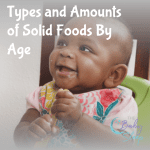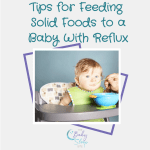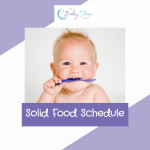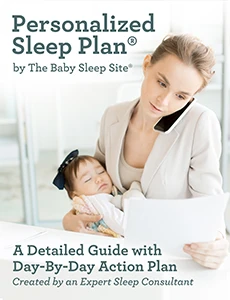
So you now know when to start your baby on solid foods, and you may have decided that the time is now — your baby’s ready! Now, it’s time to feed your little one solids for the first time. But that can be easier said than done. How should you introduce solids? What foods should you begin with? Cereal? Fruits and Veggies? Help!
Introducing Solids: What Should Be Your Baby’s First Foods?
When it comes to introducing solids, infant cereals (particularly rice cereal) are traditionally recommended as the best first foods for baby. These make great starting foods because their texture is soft and smooth, and their taste is fairly bland. They can also be mixed with formula or breastmilk, making their flavor familiar to baby and making the transition to solids even easier. Finally, infant cereals are unlikely to cause an allergic reaction, and they’re fortified with iron (something babies start needing more of around 6 months of age).
However, research has shown that cereal is not always the best starting food for babies. Today, some health experts recommend starting with fruits and vegetables (pureed, of course), or substituting whole grain oatmeal for powdered infant cereal. They suggest that bananas, avocado, or sweet potatoes are excellent first foods since they’re sweet (like breastmilk) and easy to mash.
In general, it’s best to delay the introduction of allergy-causing foods (see below) and start with foods that are considered safe for your 4-6 month old baby (like the ones listed above). Of course, all babies are different and we’ve heard of babies being allergic to even banana. This is rare, but you will want to take it slow with any new foods (see “4-day rule” below)!
Introducing Solids: What About Food Allergies and Eczema?
Food allergies can make any mom worry, but you may be particularly concerned if you have a family history of food allergies or of eczema (a skin condition that can be an indicator of food allergies.) If that’s the case, you will want to be even more careful about watching for allergic reactions in your baby or how you introduce new foods to your baby.
Regardless of whether or not your family has a history of food allergies, it’s recommended that you introduce individual foods one at a time. In other words, don’t mix peas and carrots together if both are brand new foods for your baby. Offer them separately. What’s more, you should follow the “4 Day Rule”: wait about 4 days in between introducing a new food to your baby. That will give you time to see if an allergic reaction develops, and it’ll help you better determine which food is responsible for the reaction. And if food allergies run in your family, be especially careful to introduce foods this way.
You don’t have to delay introducing any foods – the old “rule” to introduce typically allergenic foods like peanuts and shellfish after 12 months of age no longer applies. However, if you are introducing an allergenic food – especially if a history of such allergies runs in your family – observe your baby closely after offering that particular food.
Food Sensitivities/Intolerances vs. Food Allergies
Keep in mind, too, that while your baby may not develop a true food allergy, he may have some food sensitivities or food intolerances. Food sensitivities and intolerances are more common than true food allergies. For instance, true milk allergies aren’t that common, but milk sensitivities and intolerances are.
In addition, The symptoms of food sensitivities and intolerances are usually less severe than true food allergies. For example, after eating a new food, you might notice that your baby has a night of poor or restless sleep. Or you might notice that he seems gassy after eating something new. These can be signs of a food intolerance.
For more information about food intolerances/sensitivities, and how they’re different from true food allergies, check out this article on mayoclinic.com.
Introducing Solids: Should I Still Breastfeed/Bottle Feed?
Oh, yes! The fact that your baby is eating solids now doesn’t mean you should cut out (or even cut back on) breastmilk or formula. The American Academy of Pediatrics (AAP) recommends that breastmilk or formula be your baby’s primary source of nutrition for the first year. Therefore, your goal in introducing your baby to solids isn’t to provide her with nutrition that she’s not getting from breastmilk or formula. Breastmilk and formula still give her all the nutrition she needs. Rather, you’re introducing solids in order to give her some practice at eating (and eventually feeding herself) solid foods. To be sure that your baby’s getting enough breastmilk or formula, check out our Amounts of Solid Foods by Age chart; it includes recommended daily amounts.
Keep this in mind as you start feeding your baby solids; if you notice that he’s eating more and drinking less than his required daily amount, reduce the amount of solid food you offer and try to increase his nursing or bottle feeding to ensure that he’s getting enough breastmilk or formula. Solid food will fill him up (and those extra calories will be necessary as he gets bigger), but it won’t offer the same nutrition as breastmilk or formula.
Introducing Solids: Slow and Steady is the Way to Go!
A final word about how to introduce solids: make “slow and steady” your mantra as you introduce your baby to this new way of eating. Remember, this is a big change for your baby — her eating now involves new tastes, new textures, and new skills on her part (like chewing!) As with anything new, your baby’s going to need some practice with eating solid food before she gets “good” at it.
So be prepared to be patient. In the beginning, meals will likely be long and messy. You may wonder if your baby’s gotten any food in his belly after you see how much he’s managed to smear in his hair and on his face! That’s the fun part! 🙂 Or, you may find that it takes 45 minutes to get finish a few tablespoons of cereal. But that’s okay! It’s all part of the learning process. Slowly, steadily, your baby will figure it out, and eating will be more fun and less work!
Everything You Need To Know About Starting Solids – All In One e-Book!
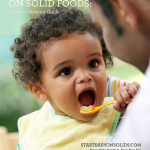 What if you could find everything you needed to know about starting your baby on solid foods – when it’s best to start solids, how to introduce solids, complications, food allergies, etc. – in one easy-reference guide? Now you can! Your Baby’s Start To Solid Foods: A Comprehensive Guide will walk you through every step of starting solids. Plus, your e-Book package includes several bonus materials, designed to maximize your success in starting solids. You’ll get a thorough guide to treating constipation, a dietitian’s advice on how to avoid 5 common solid-foods mistakes, and a weekly meal plan for your baby’s first year. Grab your e-Book today, and ensure your baby has the healthiest possible start to solid foods!
What if you could find everything you needed to know about starting your baby on solid foods – when it’s best to start solids, how to introduce solids, complications, food allergies, etc. – in one easy-reference guide? Now you can! Your Baby’s Start To Solid Foods: A Comprehensive Guide will walk you through every step of starting solids. Plus, your e-Book package includes several bonus materials, designed to maximize your success in starting solids. You’ll get a thorough guide to treating constipation, a dietitian’s advice on how to avoid 5 common solid-foods mistakes, and a weekly meal plan for your baby’s first year. Grab your e-Book today, and ensure your baby has the healthiest possible start to solid foods!

